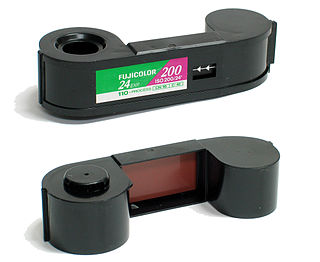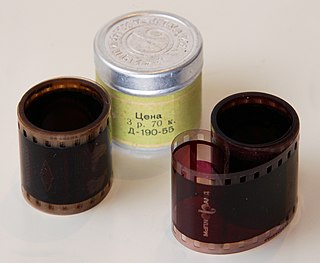Related Research Articles

35 mm film is a film gauge used in filmmaking, and the film standard. In motion pictures that record on film, 35 mm is the most commonly used gauge. The name of the gauge is not a direct measurement, and refers to the nominal width of the 35 mm format photographic film, which consists of strips 1.377 ± 0.001 inches (34.976 ± 0.025 mm) wide. The standard image exposure length on 35 mm for movies is four perforations per frame along both edges, which results in 16 frames per foot of film.

110 is a cartridge-based film format used in still photography. It was introduced by Kodak in 1972. 110 is essentially a miniaturized version of Kodak's earlier 126 film format. Each frame is 13 mm × 17 mm, with one registration hole. Cartridges with 12, 20, or 24 frames are available on-line. Production variations sometimes have allowed for an additional image.

Vitagraph Studios, also known as the Vitagraph Company of America, was a United States motion picture studio. It was founded by J. Stuart Blackton and Albert E. Smith in 1897 in Brooklyn, New York, as the American Vitagraph Company. By 1907, it was the most prolific American film production company, producing many famous silent films. It was bought by Warner Bros. in 1925.

The Cinerama Dome is a movie theater located at 6360 Sunset Boulevard in Hollywood, California. Designed to exhibit widescreen Cinerama films, it opened November 7, 1963. The original developer was William R. Forman, founder of Pacific Theatres. The Cinerama Dome continued as a leading first-run theater, most recently as part of the ArcLight Hollywood complex, until it closed temporarily in March 2020, due to the COVID-19 pandemic in California. The ArcLight chain closed permanently in April 2021, with the theater never having reopened. In June 2022, it was announced that there are plans to reopen it and the former ArcLight Hollywood under a new name, Cinerama Hollywood.

William Wallace Halleck Reid was an American actor in silent film, referred to as "the screen's most perfect lover". He also had a brief career as a racing driver.

Bell and Howell LLC is a U.S.-based services organization and former manufacturer of cameras, lenses, and motion picture machinery, founded in 1907 by two projectionists, and originally headquartered in Wheeling, Illinois. The company is now headquartered in Durham, North Carolina, and currently sells production mail equipment, buy-online-pickup-in-store (BOPIS) smart locker and kiosk solutions, and provides maintenance services for automated, industrial equipment in enterprise-level companies. Since 2010, the Bell + Howell brand name has been extensively licensed for a diverse range of consumer electronics products.

The Biograph Company, also known as the American Mutoscope and Biograph Company, was a motion picture company founded in 1895 and active until 1916. It was the first company in the United States devoted entirely to film production and exhibition, and for two decades was one of the most prolific, releasing over 3000 short films and 12 feature films. During the height of silent film as a medium, Biograph was the most prominent U.S. film studio and one of the most respected and influential studios worldwide, only rivaled by Germany's UFA, Sweden's Svensk Filmindustri and France's Pathé. The company was home to pioneering director D. W. Griffith and such actors as Mary Pickford, Lillian Gish, and Lionel Barrymore.

The filmstrip is a form of still image instructional media, once widely used by educators in primary and secondary schools (K–12) and for corporate presentations. It was largely made obsolete by the late 1980s by newer and increasingly lower-cost full-motion videocassettes and later on by DVDs. From the 1920s to the 1980s, filmstrips provided an easy and less expensive alternative to full motion educational films, requiring little storage space and being very quick to rewind for the next use. Filmstrips were durable and rarely needed splicing. They are still used in some areas.

The Lubin Manufacturing Company was an American motion picture production company that produced silent films from 1896 to 1916. Lubin films were distributed with a Liberty Bell trademark.

James Hartness was an American inventor, mechanical engineer, entrepreneur, amateur astronomer, and politician who served as the 58th governor of Vermont from 1921 to 1923.

John J. Mescall, A.S.C. was an American cinematographer. He photographed such silent films as Ernst Lubitsch's The Student Prince in Old Heidelberg (1927), but he is best known for his work in the 1930s at Universal Pictures, where he often worked on the films of James Whale. Mescall was famous for his elaborate, some might say grandiose, effective camera movements, in which the camera would often track completely across or around a set, or even one performer. He did not always use these kinds of camera movements, but his most famous films all have them.
Herman Adolf DeVry was an American inventor, aviator, and colleague of Lee de Forest. DeVry is credited with creating the first portable motion picture projector, which he called a Theatre in a Suitcase. He was the founder of the DeVry Company.

Encyclopædia Britannica Films was the top producer and distributor of educational 16 mm films and later VHS videocassettes for schools and libraries from the 1940s through the 1990s. Prior to 1943, the company operated under the name of Electrical Research Products Inc. (ERPI) Classroom Films.
The Standard Encyclopædia of Southern Africa (SESA) is a 12-volume encyclopaedia that is principally about the Republic of South Africa and nearby countries. About 1400 people contributed to the encyclopaedia. The first two volumes were published in August 1970; the 12th and final volume was published in September 1976.

Harold Holland was a British theatre and silent film actor and playwright. He was born in Bloomsbury, London. He played Dr. Rogers in the 1913 film Riches and Rogues, and took the lead role of Dr. Thomas "Tom" Flynn in the 1914 comedy The Lucky Vest. After having worked on Charlie Chaplin films including Shanghaied and The Bank in 1915, he was hired by the Morosco Photoplay Company in 1916 as it expanded.

Tilford Cinema Corporation, also known as Tilford Cinema Studios, was a film studio business headquartered in New York City with film operations and studio activity in Miami, Florida. It was a pioneer in the studio for hire contracting system. The business was established in 1920 and was led by Walter Ford Tilford and Thomas W. Switzler.
Stella Wynne Herron was an American writer and suffragist whose work appeared in a variety of magazines, including Collier's, Sunset, and Weird Tales. She is most known for her 1916 short story "Shoes", which pioneering film director Lois Weber adapted into a film of the same name. The film is now considered a feminist classic in early cinema history.
Samuel Shipman was an American playwright. Several of his plays were adapted to film. He was Jewish.

Hugh E. Dierker was an American film director and producer.
A. H. Fischer Features was a film production company. B. A. Rolfe worked on some of its films. Charles A. Logue was the company's secretary.
References
- ↑ "Opportunities in the Motion Picture Industry: And how to Qualify for Positions in Its Many Branches". Photoplay Research Society, Bureau of Vocational Guidance. June 13, 1922 – via Google Books.
- ↑ Inklebarger, Timothy (January 26, 2016). "Former theater building is back on the market". Oak Park.
- 1 2 "The American School Board Journal". Bruce Publishing Company. June 13, 1914 – via Google Books.
- ↑ "Stock Photo - Moving Picture Age (1920) . em, and let us tell you about projectors andfilms for educators. EDUCATION DEPARTMENT American Type Founders Company 300 Communipaw Ave. JERSEY CITY". Alamy.
- ↑ "The High School". June 13, 1923 – via Google Books.
- ↑ "Chicago Commerce". The Association. June 13, 1922 – via Google Books.
- ↑ "Film gauges". www.nfsa.gov.au. July 8, 2010.
- ↑ "Tractor World". June 13, 1918 – via Google Books.
- ↑ "Atlas Educational Film Co., The - Discography of American Historical Recordings". adp.library.ucsb.edu.
- ↑ "Answers from Atlas". WorldCat.org. Retrieved September 10, 2023.
- ↑ "Trade catalogs on educational slides and equipment". WorldCat.org. Retrieved September 10, 2023.
- ↑ Education, University of Oklahoma University Extension Division Dept of Visual (June 13, 1922). "Visual Education". The University. – via Google Books.
- ↑ "The Drill press | WorldCat.org" . Retrieved September 10, 2023.
- ↑ "Bar work: Magnesium ; part l : Setting up bar mechamism and roller turner | WorldCat.org" . Retrieved September 10, 2023.
- ↑ "Bar work magnesium". WorldCat.org. Retrieved September 10, 2023.
- ↑ "Catalog of Copyright Entries. Part 1. [C] Group 3. Dramatic Composition and Motion Pictures. New Series". 1945.
- ↑ "First impressions". WorldCat.org. Retrieved September 10, 2023.
- ↑ "Giving orders". WorldCat.org. Retrieved September 10, 2023.
- ↑ "North Carolina pictorial history". WorldCat.org. Retrieved September 10, 2023.
- ↑ "Student flyer | WorldCat.org" . Retrieved September 10, 2023.
- ↑ Rick Prelinger. "the field guide to Sponsored Films" (PDF). filmpreservation.org. Retrieved September 10, 2023.